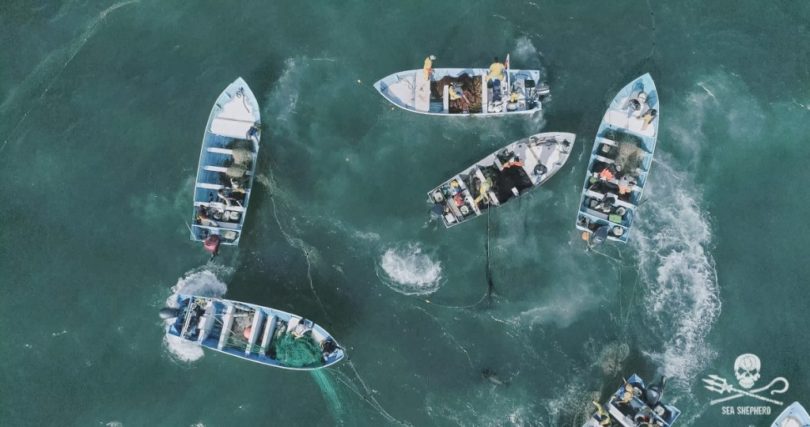Sea Shepherd Reveals Unbridled Poaching as 80 Skiffs Raid Habitat of Critically Endangered Vaquita Porpoise
Published by Sea Shepherd Conservation Society
In flagrant disregard for federal law, dozens of skiffs fishing with illegal gillnets swarmed the protected waters home to the most endangered marine mammal in the world this week.
San Felipe, MX, December 9th, 2019 – Over 80 skiffs swarmed the shores of San Felipe, Baja California yesterday in an organized effort to poach for totoaba, an endangered type of sea bass whose swim bladder is prized on the Chinese black market.
According to estimates from Sea Shepherd’s drone footage of the illegal activities at least 500 totoaba were illegally caught and slaughtered during the day’s incident. Skiffs with up to seven poachers aboard were observed catching totoaba, cutting open the fish, removing swim bladders, and dumping the bodies back into the sea.
Additional drone footage revealed poachers using a new method of fishing this season known as “Pesqueria de Encierro,” to illegally catch the totoaba bass. This method involves circling the migrating fish between several skiffs while setting as many gillnets as possible in a seine, forming an enclosure from which there is no escape.

“In previous years, poachers have let their nets drift before returning to retrieve them, enabling Sea Shepherd and the Mexican authorities we collaborate with to make quick work of hauling them out of the Vaquita Refuge,” stated Sea Shepherd Campaigns Director Locky Maclean, concluding “this new method allows the poachers to quickly encircle an entire school of totoaba while tending the nets so they are not confiscated. The prized bladders are transferred to a getaway skiff, with the dead fish thrown back to sea, gutted.”
In broad daylight, less than two miles from shore in front of the otherwise sleepy town of San Felipe in the Upper Gulf of California, Navy and Federal Inspectors were overwhelmed by the sheer number of skiffs and fishermen in the area. Sea Shepherd Campaign Leader Jean Paul Geoffroy stated: “With a total of up to 420 fishermen, and only 2 small naval speedboats able to respond, authorities were overrun, while poachers had a free-for-all.”
At 12:43pm, Captain Nick Bohnet of the M/V Sharpie, one of two former US Coast Guard cutters Sea Shepherd operates in the region to support Mexican authorities, reported that several crew members on board heard the sound of two shots fired, believed to be small arms, near a large group of skiffs. M/V Sharpie remained at a safe distance with all non-essential personnel taking cover inside the vessel. Only four days earlier, on December 4th, Sea Shepherd suffered gunshot damage to an unmanned aerial drone while documenting illegal fishing activities in the area.
“Illegal fishing for totoaba has existed for years, but Sea Shepherd crew have never observed such blatant poaching with such impunity so close to the Zero Tolerance Area, an area identified by scientists as the most important habitat for the the critically endangered vaquita porpoise,” said Sea Shepherd Science crew member Laura Sanchez.
Sea Shepherd has been present in the Upper Gulf of California since 2015 as part of Operation Milagro, a campaign to protect the most endangered marine mammal on Earth – Mexico’s Vaquita porpoise. According to last official data, fewer than 19 vaquita remain alive. The main threat to the tiny cetacean, endemic to the Upper Gulf of California, is illegal totoaba gillnet fishing.















